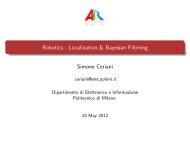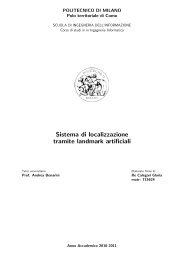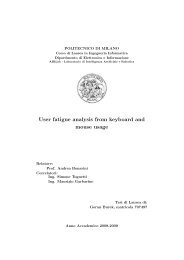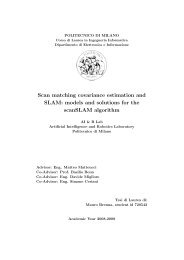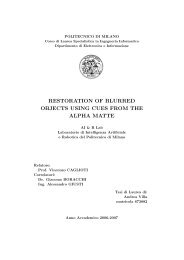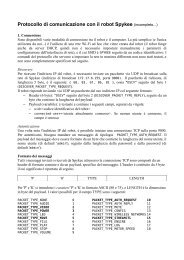Submitted version of the thesis - Airlab, the Artificial Intelligence ...
Submitted version of the thesis - Airlab, the Artificial Intelligence ...
Submitted version of the thesis - Airlab, the Artificial Intelligence ...
Create successful ePaper yourself
Turn your PDF publications into a flip-book with our unique Google optimized e-Paper software.
5.1. Camera Calibration 53<br />
<strong>the</strong> principal points in terms <strong>of</strong> pixel dimension.<br />
x = K[I|0]Xcam<br />
where Xcam as (X,Y,Z,1) t to emphasize that <strong>the</strong> camera is assumed to be<br />
located at <strong>the</strong> origin <strong>of</strong> a Euclidean coordinate system with <strong>the</strong> principal<br />
axis <strong>of</strong> <strong>the</strong> camera point straight down <strong>the</strong> z-axis, and <strong>the</strong> point Xcam is<br />
expressed in <strong>the</strong> camera coordinate system.<br />
In general, points in <strong>the</strong> space will be expressed in terms <strong>of</strong> a different<br />
Euclidean coordinate frame, known as <strong>the</strong> world coordinate frame. The two<br />
frames are related via a rotation and a translation. The relation between<br />
<strong>the</strong> two frames can be represented as follows:<br />
x = KR[I|−C]X<br />
where X is now in a world coordinate frame. This is <strong>the</strong> general mapping<br />
given by a pinhole camera (In Figure 5.2). A general pinhole camera,<br />
P = KR[I| − C], has a 9 degrees <strong>of</strong> freedom: 3 for K, 3 for R, 3 for C.<br />
The parameters contained in K are called internal camera parameters. The<br />
parameters <strong>of</strong> R and C which relate <strong>the</strong> camera orientation and position to<br />
a world coordinate system are called <strong>the</strong> external parameters. In a compact<br />
form, <strong>the</strong> camera matrix is<br />
where t = −RC.<br />
P = K[R|t]<br />
The camera matrix, which consists <strong>of</strong> internal and external camera parameters,<br />
is calculated by <strong>the</strong> camera calibration toolbox automatically.<br />
Having <strong>the</strong> internal and external camera parameters from <strong>the</strong> toolbox, we<br />
compute <strong>the</strong> homography H. Homography is an invertible transformation<br />
from <strong>the</strong> real projective plane to <strong>the</strong> projective plane.<br />
We developed two different approaches to determine <strong>the</strong> position <strong>of</strong> a<br />
target according to <strong>the</strong> robot coordinates. In <strong>the</strong> first case, <strong>the</strong> target object<br />
is a ball, and we are using <strong>the</strong> information coming from <strong>the</strong> diameter<br />
<strong>of</strong> <strong>the</strong> ball. In this case, <strong>the</strong> transformation should be a 3D to 2D, since <strong>the</strong><br />
ball can be represented in world coordinates system with <strong>the</strong> X,Y,Z and in<br />
<strong>the</strong> camera coordinates with two values X,Y. In <strong>the</strong> second case, we assume<br />
that <strong>the</strong> target object is on <strong>the</strong> ground and we are using <strong>the</strong> information<br />
coming from <strong>the</strong> intersection point <strong>of</strong> <strong>the</strong> object with <strong>the</strong> ground. This




